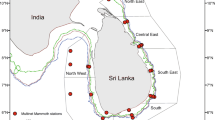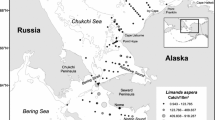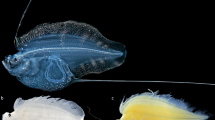Abstract
Fish larvae identification in estuarine environments is of major importance for fishing resources verifications, environmental monitoring, and establishment of protection areas. Species of the Engraulidae family are morphologically very similar; therefore, taxonomic characterization can be insufficient to reach a precise identification. Molecular-level analysis has become an important tool to assist on taxonomy, as it does not depend on morphological expressions that only occur in juvenile or adult stages. Fish larvae were sampled in tropical estuarine ecosystems, in a single water body, with salinities ranging between 15 and 25, using a bongo net with a 500-μm mesh, towed obliquely from the surface. Around 73% of identified individuals are from the Engraulidae family, and are classified into nine morphotypes according to morphological characteristics. DNA analyses were performed, with the sequencing of the mitochondrial gene Cytochrome C Oxidase I. These analyses suggest the occurrence of two distinct genera: Anchoa and Lycengraulis, among the investigated specimens. The present study contributes to enriching knowledge on the morphology of larvae of the Engraulidae family, and highlights the potential of molecular analysis techniques to elucidate taxonomic issues.












Similar content being viewed by others
References
Afrand M, Sourinejad I, Fazeli SAS, Akbarzadeh A, Yeganeh LP, Sadeghi M, Azarbaijani R (2020) Morphological identification and molecular validation of anchovies (Engraulidae) in the Persian Gulf and Oman Sea. Zootaxa 4742(2):375–391. https://doi.org/10.11646/zootaxa.4742.2.10
Aguilar R, Ogburn MB, Driskell AC, Weigt LA, Groves MC, Hines AH (2016) Gutsy genetics: identification of digested piscine prey items in the stomach contents of sympatric native and introduced warmwater catfishes via DNA barcoding. Environ Biol Fish 100:325–336. https://doi.org/10.1007/s10641-016-0523-8
Altschul SF, Gish W, Miller W, Myers EW, Lipman DJ (1990) BasicLocal Alignment Search Tool. J Mol Biol 215:403–410. https://doi.org/10.1016/S0022-2836(05)80360-2
Araújo AV, Dias CO, Bonecker SLC (2017a) Effects of environmental and water quality parameters on the functioning of copepod assemblages in tropical estuaries. Estuar Coast Shelf Sci 194:150–161. https://doi.org/10.1016/j.ecss.2017.06.014
Araújo AV, Dias CO, Bonecker SLC (2017b) Differences in the structure of copepod assemblages in four tropical estuaries: Importance of pollution and the estuary hydrodynamics. Elsevier, Mar Pollut Bull 115(1-2):412–420. https://doi.org/10.1016/j.marpolbul.2016.12.047
Azevedo MFC, Oliveira C, Pardo BG, Martínez P, Foresti F (2008) Phylogenetic analysis of the order Pleuronectiformes (Teleostei) based on sequences of 12S and 16S mitochondrial genes. Genet Mol Biol 31(1):284–292. https://doi.org/10.1590/S1415-47572008000200023
Azmir IA, Esa Y, Amin SMN, Md Yasin IS, Md Yusof FZ (2017) Identification of larval fish in mangrove areas of Peninsular Malaysia using morphology and DNA barcoding methods. J Appl Ichthyol 33(5):998–1006. https://doi.org/10.1111/jai.13425
Bingpeng X, Heshan L, Zhilan Z, Chunguang W, Yanguo W, Jianjun W (2018) DNA barcoding for identification of fish species in the Taiwan Strait. PlosOne 13(6):13. https://doi.org/10.1371/journal.pone.0198109
Bloom DD, Lovejoy NR (2012) Molecular phylogenetics reveals a pattern of biome conservatism in New World anchovies (Family Engraulidae). J Evol Biol 25:701–715. https://doi.org/10.1111/j.1420-9101.2012.02464.x
Bonecker ACT, Castro MS (2006) Atlas de larvas de peixes da região central da Zona Econômica Exclusiva brasileira. REVIZEE, Museu Nacional, Rio de Janeiro, 213 pp.
Bonecker ACT, Namiki CAP, Castro MS, Campos PN (2014) Catálogo dos estágios iniciais de desenvolvimento dos peixes da bacia de Campos. Sociedade Brasileira de Zoologia, Zoologia: guias e manuais de identificação, Curitiba.
Carvalho JP (1950) Engraulídeos brasileiros do gênero Anchoa. Boletim do Instituto Paulista de Oceanografia 1(2). https://doi.org/10.1590/S0100-42391950000200004
Carvalho DC, Palhares RM, Drummond MG, Frigo TB (2014) DNA Barcoding identification of commercialized seafood in South Brazil: a governmental regulatory forensic program. Elsevier, Food Control 50:784–788. https://doi.org/10.1016/j.foodcont.2014.10.025
Carvalho PF, Bonecker SLC, Nassar CAG (2016) Analysis of the Appendicularia class (subphylum Urochordata) as a possible tool for biomonitoring four estuaries of the tropical region. Environ Monit Assess 188(11):14. https://doi.org/10.1007/s10661-016-5616-5
Chairi H, Rebordinos L (2014) A rapid method for differentiating four species of the Engraulidae (Anchovy) family. J Agric Food Chem 62(13):2803–2808. https://doi.org/10.1021/jf405680g
Díaz J, Villanova GV, Brancolini F, del Pazo F, Posner VM, Grimberg A, Arranz SE (2016) First DNA Barcode reference library for the identification of South American freshwater fish from the Lower Paraná River. PLoS One 11(7):20. https://doi.org/10.1371/journal.pone.0157419
Díaz-Viloria N, Sánchez-Velasco L, Lavín MF, Perez-Enriquez R, Jiménez-Rosenberg SPA, Godínez VM (2015) Genetic corroboration of Engraulis mordax larvae in the upper Gulf of California, a previously undescribed spawning habitat. Ichthyol Res 62(2):230–235. https://doi.org/10.1007/s10228-014-0423-x
Ebach MC, Holdrege C (2005) DNA barcoding is no substitute for taxonomy. Nature 434(7034):697. https://doi.org/10.1038/434697b
Elías-Gutiérrez M, Valdez-Moreno M, Topan J, Young MR, Cohuo-Colli JA (2017) Improved protocols to accelerate the assembly of DNA barcode reference libraries for freshwater zooplankton. Ecol Evol 8(5):3002–3018. https://doi.org/10.1002/ece3.3742
Figueiredo IL, Menezes NA (1978) Manual de peixes marinhos do sudeste do Brasil - Teleostei Vol. 1. Museu de Zoologia da Universidade de São Paulo, São Paulo
Fricke R, Eschmeyer WN, Fong JD (2020) Eschmeyer's catalog of fishes: Genera/Species by family / subfamily. Available online: http://researcharchive.calacademy.org/research/ichthyology/catalog/SpeciesByFamily.asp. Electronic version accessed July 2020.
Fuster de Plaza ML, Boschi EE (1961) Areas de migración y ecologia de la Anchoa Lycengrauli solidus (Günther) em las aguas Argentinas (Pisces, Fam. Engraulidae). Reimpresión de Contribuciones Científicas, Universidad de Buenos Aires, Facultad de Ciencias Exactas y Naturales, Serie Zoología 1(3):127–183
Green MR, Sambrook J (2012) Molecular cloning – a laboratory manual. Edição 4, Volume 1. Cold Spring Harbor Laboratory Press, Cold Spring Harbor, New York
Hajibabaei M, Waard JR, Ivanova NV, Ratnasingham S, Dooh RT, Kirk SL, Mackie PM, Hebert PDN (2005) Critical factors for assembling a high volume of DNA barcodes. Philos Trans R Soc 360(1462):1959–1967. https://doi.org/10.1098/rstb.2005.1727
Hasegawa M, Kishino H, Yano T (1985) Dating of the human-ape splitting by a molecular clock of mitochondrial DNA. J Mol Evol 22(2):160–174
Hebert PDN, Cywinska A, Ball SL, Waard JR (2003a) Biological identifications through DNA barcodes. The Royal Society 270(1512):313–321. https://doi.org/10.1098/rspb.2002.2218
Hebert PDN, Ratnasingham S, Waard JR (2003b) Barcoding animal life: cytochrome c oxidase subunit 1 divergences among closely related species. The Royal Society 270(1):96–99. https://doi.org/10.1098/rsbl.2003.0025
Hebert PDN, Penton EH, Burns JM, Janzen DH, Hallwachs W (2004) Ten species in one: DNA barcoding reveals cryptic species in the neotropical skipper butterfly Astraptes fulgerator. PNAS 101(41):14812–14817. https://doi.org/10.1073/pnas.0406166101
Inoue JG, Miya M, Tsukamoto K, Nishida M (2001) Complete mitochondrial DNA sequence of the Japanese anchovy Engraulis japonicus. Fish Sci 67(5):828–835. https://doi.org/10.1046/j.1444-2906.2001.00329.x
Ivanova NV, Zemlak TS, Hanner RH, Hebert PDN (2007) Universal primer cocktails for fish DNA barcoding. Mol Ecol 7:544–548. https://doi.org/10.1111/j.1471-8286.2007.01748.x
Jerôme M, Martinsohn JT, Ortega D, Carreau P, Verrez-Bagnis V, Mouchel O (2008) Toward fish and seafood traceability: anchovy species determination in fish products by molecular markers and support through a public domain database. J Agric Food Chem 56(10):3460–3469. https://doi.org/10.1021/jf703704m
Isari S, Pearman JK, Casas L, Michell CT, Curdia J, Berumen ML, Irigoien X (2017) Exploring the larval fish community of the central Red Sea with an integrated morphological and molecular approach. PlosOne 12(8):24. https://doi.org/10.1371/journal.pone.0182503
Keskín E, Atar HH (2013) DNA barcoding commercially important fish species of Turkey. Mol Ecol Resour 13(5):788–797. https://doi.org/10.1111/1755-0998.12120
Ko HL, Wang YT, Chiu TS, Lee MA, Leu MY, Chang KZ, Chen WY, Shao KT (2013) Evaluating the accuracy of morphological identification of larval fishes by applying DNA barcoding. PlosOne 8(1):7. https://doi.org/10.1371/journal.pone.0053451
Kochzius M, Seidel C, Antoniou A, Botla SK, Campo D, Cariani A, Vazquez EG, Hauschild J, Hervet C, Hjörleifsdottir S, Hreggvidsson G, Kappel K, Landi M, Magoulas A, Marteinsson V, Nölte M, Planes S, Tinti F, Turan C et al (2010) Identifying fishes through DNA barcodes and microarrays. PlosOne 5(9):15. https://doi.org/10.1371/journal.pone.0012620
Kumar S, Stecher G, Tamura K (2016) Mega 7: molecular evolutionary genetics analysis version 7.0 for bigger dataset. Mol Biol Evol 33(7):1870–1874. https://doi.org/10.1093/molbev/msw054
Larkin MA, Blackshields G, Brown NP, Chenna R, Mcgettigan PA, Mcwillian H, Valentin F, Wallace LM, Wilm A, Lopez R, Thompson JD, Gibson TJ, Higgins DG (2007) Clustal W andClustal X version 2.0. Bioinformatics 23:2947–2948. https://doi.org/10.1093/bioinformatics/btm404
Lavoué S, Miya M, Nishida M (2010) Mitochondrial phylogenomics of anchovies (family Engraulidae) and recurrent origins of pronounced miniaturization in the order Clupeiformes. Mol Phylogenet Evol 56:480–485. https://doi.org/10.1016/j.ympev.2009.11.022
Lavoué S, Miya M, Musikasinthorn P, Chen WJ, Nishida M (2013) Mitogenomic evidence for an Indo-West Pacific origin of the Clupeoidei (Teleostei: Clupeiformes). PlosOne 8(2):15. https://doi.org/10.1371/journal.pone.0056485
Lefébure T, Douady CJ, Gouy M, Gibert J (2006) Relationship between morphological taxonomy and molecular divergence within Crustacea: proposal of a molecular threshold to help species delimitation. Mol Phylogenet Evol 40:435–447
Li C, Ortí G (2007) Molecular phylogeny of Clupeiformes (Actinopterygii) inferred from nuclear and mitochondrial DNA sequences. Elsevier, Mol Phylogenet Evol 44(1):386–398. https://doi.org/10.1016/j.ympev.2006.10.030
Loeb MV (2009) Revisão taxonômica das espécies do gênero Anchoviella Fowler, 1911 (Clupeiformes, Engraulidae) das Bacias Amazônica e do São Francisco. Dissertação, Programa de Pós-Graduação em Zoologia, Instituto de Biociências, Universidade de São Paulo.
Loeb, M.V. (2015) Relações filogenéticas de Engraulinae e revisão do gênero Anchoviella Flowler, 1911 (Clupeiformes, Engraulidae). Tese, Programa de Pós-Graduação em Sistemática, Taxonomia Animal e Biodiversidade, Museu de Zoologia, Universidade de São Paulo.
Ma CY, Ma HY, Ni Y, Wang W, Ma LB (2015) Molecular identification of the genus Thryssa based on DNA barcoding. Genet Mol Res 14(4):18580–18586. https://doi.org/10.4238/2015.December.28.5
Mabragaña E, Astarloa JMD, Hanner R, Zhang J, Castro MG (2011) DNA barcoding identifies Argentine fishes from marine and brackish waters. PlosOne 6(12):11. https://doi.org/10.1371/journal.pone.0028655
Malabarba LR, Neto PC, Bertaco VA, Carvalho TP, Santos JF, Artioli LGS (2013) In: ANAMA (ed) Guia de identificação dos peixes da Bacia do rio Tramandaí. Via Sapiens, Projeto Taramandahy, Porto Alegre
Metcalf JL, Pritchard VL, Silvestri SM, Jenkins JB, Wood JS, Cowley DE, Evans RP, Shiozawa DK, Martin AP (2007) Across the great divide: genetic forensics reveals misidentification of endangered cutthroat trout populations. Mol Ecol 16(21):4445–4454. https://doi.org/10.1111/j.1365-294X.2007.03472.x
Oliveira JA, Crispim BA, Martins NM, Silva AO, Dourado PLR, Rocha MP, Grisolia AB (2013) Sequências de gene mitocondrial para identificação de espécies animais. Revista Colombiana de Ciencia Animal 5(2):396–407
Packer L, Gibbs J, Sheffield C, Hanner R (2009) DNA barcoding and the mediocrity of morphology. Barcoding Methodol Appl Mol Ecol Res 9(1):42–50. https://doi.org/10.1111/j.1755-0998.2009.02631.x
Padial JM, De La Riva I (2007) Integrative taxonomists should use and produce DNA barcodes. Zootaxa 1586:67–68. https://doi.org/10.11646/zootaxa.1586.1.7
Paine MA, McDowell JR, Graves JE (2007) Specific identification using COI sequence analysis of Scombrid larvae collected off the Kona coast of Hawaii Island. Ichthyol Res 55(1):7–16. https://doi.org/10.1007/s10228-007-0003-4
Pires AC, Marinoni L (2010) DNA barcoding and traditional taxonomy unified through Integrative Taxonomy: a view that challenges the debate questioning both methodologies. Biota Neotropica 10(2):339–346. https://doi.org/10.1590/S1676-06032010000200035
Rajpoot A, Kumar VP, Bahuguna A, Kumar D (2016) DNA barcoding and traditional taxonomy: an integrative approach. Int J Curr Res 8(11):42025–42031
Ribeiro AO, Caires RA, Mariguela TC, Pereira LHG, Hanner R, Oliveira C (2012) DNA barcodes identify marine fishes of São Paulo State, Brazil. Mol Ecol Resour 12(6):1012–1020. https://doi.org/10.1111/1755-0998.12007
Richards WJ (2006) Early stages of Atlantic fishes: an identification guide for the Western North Atlantic. Volume I. and Volume II. CRC Press, Boca Raton, Florida: 2640 p.
Rosas U, Menendez F, Cornejo R, Canales R, Velez-Zuazo X (2018) Fish DNA barcoding around large marine infrastructure for improved biodiversity assessment and monitoring. Mitochondrial DNA, A DNA Map Seq Anal 29(8):1174–1179. https://doi.org/10.1080/24701394.2018.1431225
Rüber L, Van Tassell JL, Zardoya R (2003) Rapid speciation and ecological divergence in the American Seven-Spined Gobies (Gobiidae, Gobiosomatini) inferred from a molecular phylogeny. Evolution 57(7):1584–1598. https://doi.org/10.1554/02-668
Santos S, Gomes MF, Ferreira ARS, Sampaio I, Schneider H (2013) Molecular phylogeny of the western South Atlantic Sciaenidae based on mitochondrial and nuclear data. Elsevier, Mol Phylogenet Evol 66(1):423–428. https://doi.org/10.1016/j.ympev.2012.09.020
Santos RVS, Ramos S, Bonecker ACT (2017a) Environmental control on larval stages of fish subject to specific salinity range in tropical estuaries. Reg Stud Mar Sci 13:42–53. https://doi.org/10.1016/j.rsma.2017.03.010
Santos RVS, Ramos S, Bonecker ACT (2017b) Can we assess the ecological status of estuaries based on larval fish assemblages? Mar Pollut Bull 124(1):367–375. https://doi.org/10.1016/j.marpolbul.2017.07.043
Silva MA (2006) Variações morfo-merísticas da manjuba Lycengraulis grossidens (Agassiz, 1829) ao longo da costa brasileira. Tese, Biologia Animal, Universidade Federal Rural do Rio de Janeiro.
Silva ACG, Severi W, Castro MF (2010) Morphological development of Anchoviella vaillanti (Steindachner, 1908) (Clupeiformes: Engraulidae) larvae and early juveniles. Neotrop Ichthyol 8(4):805–812
Silva SA, Kavalco KF, Pazza R (2012) Uso do sequenciamento de genes mitocondriais na identificação de filés de salmão. Evolução e Conservação da Biodiversidade 3(2):64–67
Smith PJ, McVeagh SM, Steinke D (2008) DNA barcoding for the identification of smoked fish products. J Fish Biol 72(2):464–471. https://doi.org/10.1111/j.1095-8649.2007.01745.x
Tresbach RH, Cerqueira NM, Medeiros SR, Gutierrez HJP, Hernández NO, Rodrigues MDN (2015) Dna barcoding: uma ferramenta de apoio molecular para identificação de espécies de peixes. Scientia Agraria Paranaensis, Marechal Cândido Rondon 14(2):77–81. https://doi.org/10.1818/sap.v14i2.10408
Valdez-Moreno M, Vásquez-Yeomans L, Elías-Gutiérrez M, Ivanova NV, Hebert PDN (2010) Using DNA barcodes to connect adults and early life stages of marine fishes from the Yucatan Peninsula, Mexico: potential in fisheries management. Mar Freshw Res 61(6):665–671. https://doi.org/10.1071/MF09222
Ward RD, Zemlak TS, Innes BH, Last PR, Hebert PDN (2005) DNA barcoding Australia’s fish species. Philos Trans R Soc:1847–1857. https://doi.org/10.1098/rstb.2005.1716
Ward RD, Hanner R, Hebert PDN (2009) The campaign to DNA bascode all fishes, FISH-BOL. J Fish Biol 74:329–356. https://doi.org/10.1111/j.1095-8649.2008.02080.x
Weigt LA, Baldwin CC, Driskell A, Smith DG, Ormos A, Reyier EA (2012) Using DNA barcoding to assess Caribbean reef fish biodiversity: expanding taxonomic and geographic coverage. PLoS One 7(7):7. https://doi.org/10.1371/journal.pone.0041059
Weiss G, Souza JAF (1977) Estudo comparativo preliminar de post-larvas e juvenis das três espécies de Engraulidae da costa sul do Brasil, Uruguai e Argentina. Atlântica, Fundação Universidade do Rio Grande, Rio Grande do Sul 2(1):1–20
Whitehead PJP, Nelson GJ, Wongratana T (1988) FAO species catalogue. Clupeoid fishes of the world (Suborder Clupeoidei). An annotated and illustrated catalogue of the herrings, sardines, pilchards, sprats, anchovies and wolf-herrings. Vol.7, Part 2. Engraulididae. FAO Fisheries Synopsis, Roma: 305–579.
Wibowo A, Wahlberg N, Vasemägi A (2016) DNA barcoding of fish larvae reveals uncharacterised biodiversity in tropical peat swamps of New Guinea, Indonesia. Mar Freshw Res 68(6):1079–1087. https://doi.org/10.1071/MF16078
Will KW, Rubinoff D (2004) Myth of the molecule: DNA barcodes for species cannot replace morphology for identification and classification. Cladistics 20:47–55
Yang JQ, Hsu KC, Zhou XD, Kuo PH, Lin HD, Liu D, Bao BL, Tang WQ (2016) New insights on geographical/ecological populations within Coilia nasus (Clupeiformes: Engraulidae) based on mitochondrial DNA and microsatellites. Mitochondrial DNA, A DNA Map Seq Anal 29(1):158–164. https://doi.org/10.1080/24701394.2016.1261850
Yu ZN, Kong XY, Guo TH, Jiang YY, Zhuang ZM, Jin XS (2005) Mitochondrial DNA sequence variation of Japanese anchovy Engraulis japonicus from the Yellow Sea and East China Sea. Fish Sci 71:299–307. https://doi.org/10.1111/j.1444-2906.2005.00964.x
Zhang J, Hanner R (2012) Molecular approach to the identification of fish in the South China Sea. PLoS One 7(2):9. https://doi.org/10.1371/journal.pone.0030621.g001
Acknowledgements
We are grateful to the entire Laboratório Integrado de Zooplâncton e Ictioplâncton (UFRJ) team, especially to Dr. Adriana Valente, MSc. Pedro Freitas and Dr. Régis Santos for the fieldwork, to Dr. Márcia Castro for her valuable help in identification, again to MSc. Pedro Freitas for the pictures of fish larvae, and to Dr. Flavia Guerra for companionship and her help in experiments and in the processing of molecular data. To the entire Laboratório de Metabolismo Macromolecular Firmino Torres de Castro (UFRJ) team for their assistance in molecular analyses, especially Dr. Victor Hugo Giordano Dias, Dr. Isadora C. Toledo e Mello, and MSc. Maria Clara da Costa Simas. We thank Dr. Michelle Klautau for all the help and suggestions in the development of the phylogenetic tree; Dr. Paulo Paiva for his help with the molecular samples; and Dr. Inácio Domingos da Silva Neto for the availability of the Laboratório de Protistologia (UFRJ). We would like to thank Maíra Rizzo for English language editing. We thank the journal reviewers for the time to read and critically evaluate our work, and for suggestions that greatly improved the original manuscript.
Funding
This study was funded by Fundação Carlos Chagas Filho de Amparo à Pesquisa do Estado do Rio de Janeiro (FAPERJ, E-26/110.363/2012).
Author information
Authors and Affiliations
Corresponding author
Ethics declarations
Conflict of Interest
The authors declare no competing interests.
Ethical approval
This article does not contain any studies with animals performed by any of the authors.
Sampling and field studies
All necessary permits for sampling and observational field studies have been obtained by the authors from the competent authorities and are mentioned in the acknowledgements when applicable.
Data availability
All data generated and/or analyzed during the current study are included in this published article and its supplementary information files.
Author contribution
MMJ participated in the fieldwork study, analyzed the molecular data, and wrote the paper. COD and ACTB analyzed the data and revised the paper. RS designed the molecular analysis and revised the paper. SLCB designed and participated in the fieldwork study, and revised the paper. All the authors edited the manuscript.
Additional information
Communicated by S. Weigmann
Publisher’s note
Springer Nature remains neutral with regard to jurisdictional claims in published maps and institutional affiliations.
Rights and permissions
About this article
Cite this article
Julio, M.M., Bonecker, A.C.T., de Oliveira Dias, C. et al. Engraulidae (Teleostei, Clupeiformes) in tropical estuarine ecosystems: identification of fish larvae based on morphological analysis and molecular evidence. Mar. Biodivers. 52, 29 (2022). https://doi.org/10.1007/s12526-022-01267-3
Received:
Revised:
Accepted:
Published:
DOI: https://doi.org/10.1007/s12526-022-01267-3




